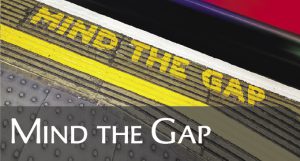
Watch for the “will dos” and the “won’t dos” in an ever-changing market
E&S coverage isn’t unique to commercial lines accounts. High-risk personal lines accounts, such as homes with too many claims or homes located in disaster-prone areas, are also prime candidates for E&S coverage.
By Marc McNulty, CIC, CRM
In the last Mind the Gap column, we discussed a few topics that our agency’s 23-year-old part-time employee found weren’t extensively covered in his property and casualty pre-licensing study material. The good news for him is that those items weren’t needed to pass the test (which he did); the bad news is that the pre-licensing study materials tend to leave new agents woefully underprepared for the real world.
One such example is in the form of excess and surplus lines insurance. He said the topic was briefly discussed, but nothing of real substance was presented.
I certainly remember that the first few E&S quotes I saw were unlike those I saw in the standard market … but fortunately I had quality mentors who advised me of potential pitfalls to avoid with such quotes. I’d like to pass along some of that knowledge to the next generation of producers and service personnel who are dipping their toes into the world of E&S coverage.
What exactly is E&S coverage?
Progressive has a terrific overview on their commercial lines website of what E&S coverage is:
“Excess and surplus lines (E&S) insurance is a market that protects high-risk businesses that standard insurers won’t cover. This market is also known as surplus lines or non-admitted insurance.
“Companies with unusual or elevated risks often need E&S insurance because the admitted market considers them too risky to cover. These businesses could get a policy through a qualified E&S carrier.” (To learn more, visit www.progressivecommercial.com/business-insurance/excess-and-surplus-insurance/)
However, note that E&S coverage isn’t unique to commercial lines accounts. High-risk personal lines accounts, such as homes with too many claims or homes located in disaster-prone areas, are also prime candidates for E&S coverage.
What is unique about E&S insurance is that the market appetite for this coverage is constantly changing.
In good times, when loss ratios are low and carrier profits are high, preferred insurance companies are more willing to write accounts with a “little hair” on them. However, during hard markets, such as the one we’re currently in, carrier appetites tighten, leaving agents to scramble for options.
This is where E&S coverage comes into play. But, as we will soon see, the quotes you receive from your E&S markets may not be the equivalent of what you’re accustomed to in the preferred marketplace.
How do you obtain E&S quotes?
E&S coverage is typically obtained through a wholesale broker or a managing general agent (MGA). These organizations offer coverage via specialty markets that retail agencies cannot directly access, so in essence they are insurance agencies for insurance agencies.
When you have a prospect that isn’t a good fit for your standard and/or preferred carriers, it is always a good idea to first contact your agency’s preferred E&S broker or MGA to see if any supplemental applications are required as part of the submission. This will help you to avoid multiple back-and-forth communications with your prospect in which you request additional information from them.
“Supplementals” are very common in E&S business and allow the underwriters to get a better grasp on the account that is being submitted to them. And, depending on the complexity of the account’s operations, it may also help you to better understand what they do.
Once ACORD applications are completed, supplemental applications are completed, and photos are obtained (if needed), forward the submission to your broker or MGA—along with any other requested information—and they will shop your account around with their markets. They will then forward you one or more quote options (depending on how their markets respond).
I’ve found that brokers don’t always let you know what markets they have approached, so if it is important for you to let your prospect know where all you have shopped, you may need to reach out and request that information. You can then learn which carriers were contacted and why their options weren’t presented (e.g., declined to quote for underwriting reasons; pricing wasn’t competitive, etc.).
Review it in detail, as this is where things can go sideways if you aren’t careful! E&S quotes may have some extras that you aren’t expecting, and they may also lack some extras that you’ve learned to rely on.
You have a quote—what’s next?

Review it in detail, as this is where things can go sideways
if you aren’t careful! E&S quotes may have some extras
that you aren’t expecting, and they may
also lack some extras that you’ve learned to rely on.
The extras that may be included will most likely be in the form of exclusions. Quite often, E&S carriers use their own proprietary forms, so you’ll need a quote that contains hyperlinks to the carrier forms, or you’ll need to ask your contact for specimen copies of any forms that are outside your comfort zone. Carefully read through the forms to see if any hidden pitfalls are present.
You will also need to ensure that the coverage isn’t crafted in a way that can be seen as detrimental to your client, and if it is, you can properly explain how coverage may respond.
For example, I write hired and non-owned auto liability coverage for a chain of pizza restaurants, and the wholesale broker I use offered a different program this past policy term. While there was premium savings to be had by the change, there was also a significant change in coverage, as any drivers who don’t meet the definition of a “superior driver” would be covered only by state minimum limits (in Ohio, this is 25/50/25) rather than the $1 million CSL policy amount.
Obviously, it was imperative that I brought this to my insured’s attention and stressed the need for them to be diligent with their motor vehicle records (MVR) efforts.
In addition, don’t be surprised to see a deductible on your general liability (GL) quotes along with any unanticipated exclusions.
On the flip side, some of the extras you may have come to expect from your standard carriers—such as property and GL enhancement endorsements—are often not an option on E&S quotes. Yes, you may find a few extras that are built in, but don’t count on enhancement endorsements to automatically provide water backup coverage, automatic additional insured status for specified relationships, or other enhancements you rely upon.
Other E&S nuances
I asked a senior vice president of a large national broker (he is one of our agency’s first points of contact in the E&S world) if he had any additional items to share with those who may be new to the industry. He brought up several items for agents to consider:
Don’t expect a package submission to have all lines quoted with the same carrier. In fact, you can expect property, GL, and umbrellas all to be quoted with different markets for each line of coverage.
Similarly, don’t assume large property risks will be quoted under the same policy, as layering is becoming more prevalent.
Don’t assume all forms are the same! Learn to spot when a liability form is specifically providing or excluding coverage versus when one is silent.
Finally, he stated that E&S coverage not only provides options for accounts that don’t fit into the standard market, they also fill in gaps that may be left when a standard market is offering coverage for most of the account.
For example, you may have standard markets that offer quotes for various manufacturing accounts, but they probably won’t offer pollution, cyber, or product recall expense coverage for those types of businesses. Your E&S broker can swoop in to save the day by rounding out accounts by filling in such gaps.
Lean on your broker for expertise
Those new to the insurance industry may tend to shy away from accounts that don’t neatly fit into the appetites of their standard or preferred markets. However, one may find that their broker has access to one or more E&S programs that offer leading coverage for various types of nonstandard accounts.
Do yourself a favor and reach out to your E&S brokers, learn what they are good at, and lean on them for knowledge. They may offer you alternative ways to provide coverage and might even help you to get started in a niche you never even considered.
The author
Marc McNulty, CIC, CRM, is a principal at The Uhl Agency in Dayton, Ohio, and has been with the agency since 2001. He divides his time among sales, marketing, technology and operational duties. You can reach Marc at marcmcnulty@uhlagency.com.




